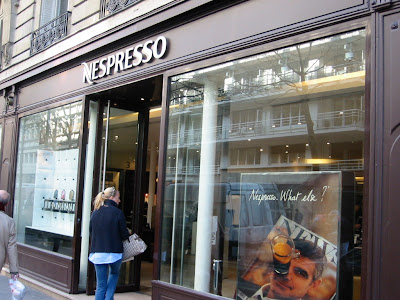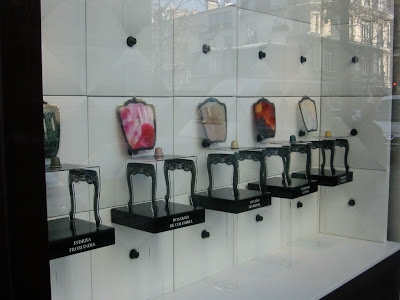
Yesterday I went to the Musée National du Moyen Age (Museum of the Middle Ages), aka the Cluny museum. Housed in former Roman thermal baths (from ~ 2nd century AD) and the Cluny Abbey (15th century), the structures alone are worth the 8 euro entry fee. But most people go for the Lady and the Unicorn tapestries, the Mona Lisa of the Cluny.
The museum has lots of other tapestries from the same era on display on the lower floor to get you worked up into a tapestry lather before you get to the Lady and the Unicorn series upstairs. They're all interesting visually-- and apparently, to at least one pair of grouchy old French ladies who wandered from tapestry to tapestry pawing each of them, tactilely-- but in the end they serve to emphasize just how elegant and lush the Lady and her friends are. Woven in the 15th century to the fantasy of just about any 5 year old girl, the 6 tapestries depict a noble Lady and her trusty white Unicorn engaged in various hijinks illustrating the 5 senses. Each of the 6 tapestries also depicts a lion, which apparently didn't market test well enough to get equal billing in the headline, while the Lady's handmaiden (whose job is mostly to hold things) and a monkey (who, like me, doesn't seem to have a job at all) make guest appearances in 4 tapestries each. Birds, sheep, bunnies, and other cute creatures make up an entertaining supporting cast.
Much has been written about the color and detail of the tapestries, but seeing them in person is another thing entirely, and there were several details I had not seen noted in the expert commentary. Though she's lovely and lithe, the Lady definitely has man-hands. Reaching into the candy bowl in Taste or playing the organ in Hearing, her digits look better suited to unclogging toilets or working a jackhammer. Maybe that's a perspective thing, or maybe giant hands and sausage fingers were a sign of good breeding in the Middle Ages. The monkey in the tapestries highlights the emphasis on the senses. In Taste he's eating a candy, in Smell he's smelling a flower. So what does it mean that in Touch that he's collared and chained to a large grinding stone? Did he cop a feel in a panel that was later deleted? He's missing entirely in Hearing, perhaps an indication that the Lady hasn't yet completed her course of organ lessons. The highlight for me was the facial expressions in Sight, in which the Lady holds a small mirror into which the Unicorn looks. The Unicorn is clearly enthralled with its own reflection, while the Lady looks on with an expression that says that she's very much over the Unicorn's vanity. The 6th tapestry is something of a mystery and has widely varying interpretations. The tent bears the inscription to my only desire and shows the Lady placing (or taking?) a jeweled necklace into/out of a box held by the handmaiden, proving perhaps that diamonds have always been a girl's best friend.
Even ignoring these superstar tapestries, there's a lot of cool stuff in the museum, from giant pillars to tiny daily objects. One that made me stop and think a minute was a set of 5 two-inch long bronze and bone adzes and ice picks that were labeled tooth picks and ear picks. Was the pointy end (no less than 2 mm square-- apparently the spaces between teeth were wider before modern dentistry) used for teeth and the adzy-end used for ears? Aside from the unpleasant thought of what might be in an ear that it would require an ice-pick to remove, it suggests a greater attention to hygiene than I'd have imagined in the 1400s.
The combination of heavy and light, bulky and delicate, is particularly interesting in the products of the Middle Ages. I've never really dug the furniture of the era-- heavy and clunky with none of the lightness or detail in the carving of the dedicated wood sculptures in the museum (or even the building structural elements-- the museum has both a 3-story high newel from a spiral staircase, carved elegantly to look like a twisting bundle of long sticks, and a wooden support beam carved with nordic-inspired dragon heads on both ends), let alone the extremely fine stone work. But the metal work is a powerful juxtaposition of heavy and light, massive hinges with rosettes cut away to leave a pattern of delicate spines with fine pointed teeth on them. Such superb craftsmanship is also evident in the small pieces of carved ivory and bone and especially in the wooden combs with perfectly, and tightly, spaced long teeth.
But perhaps my favorite part of the whole museum were 3 “books,” collections of pages from different sources compiled into hinged frames, of illuminated manuscripts. Though many illuminated texts have large elaborate images with just a little text, the examples at the Cluny tend towards large pages of text with miniature illustrations in incredibly vibrant colors. One text on the Last Judgement from the 15th century had a small, maybe 2” x 3”, panel in the text depicting Christ in the sky, sitting in judgment. Below him was an emerald-green flat earth with 3 or 4 graves, sharp rectangular openings in the earth, from which intact bodies were in various states of emergence, presumably to be judged. The intensity of the colors and crispness of the ink lines were amazing. To this 21st century observer it looked like nothing so much as the Ultimate game of whac-a-mole.
Another manuscript, a page from a small antiphonary (a liturgical text), had a small box of music notation surrounded by an especially exuberant garden of vines and leaves in the wide margins. These kinds of texts especially appeal to my OCD tendencies with their very fine, sharp lines and repeating patterns, and though the texts are mostly serious sacred documents, the artwork in some of them is surprisingly whimsical. Among the various tiny real and imaginary fauna inhabiting the garden in the margins was a naked dude riding a giant snail, the dude grasping the snail's gigantic antennae as if working a crane. It's been awhile since I've read the Bible, but I'm pretty certain I'd remember mention of naked people riding snails.
So say what you want about the glorious Renaissance with its fancy-pants linear perspective and educational reform-- I'm betting the monks of the Middle Ages were a lot more fun to party with.



















































